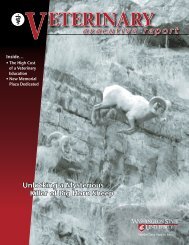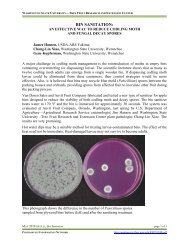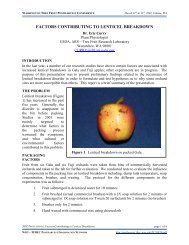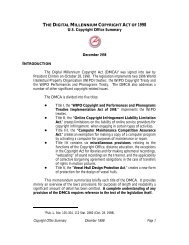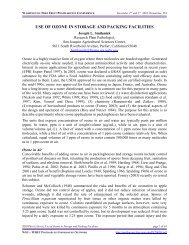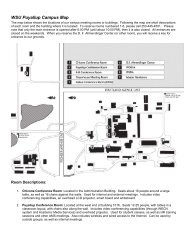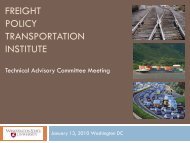Field Analytical Chemistry - Washington State University
Field Analytical Chemistry - Washington State University
Field Analytical Chemistry - Washington State University
You also want an ePaper? Increase the reach of your titles
YUMPU automatically turns print PDFs into web optimized ePapers that Google loves.
direct injection methods. A polysiloxane inlet membrane sealsthe vacuum chamber while the various GC modules are beingexchanged. Other GC/MS systems that have been modified tomake them suitable for field use are the Viking SpectraTrak GC/MS system (B18) and the Fisions MD800 system (B4).A newly redesigned SpectraTrak system was described in refsB19 and B20; this system weighs ∼20 kg without the laptopcomputer and is contained in a 33-L box; this represents areduction in size of ∼50% and a reduction in weight of ∼25% overthe first-generation system. Its mass range is 1.6-700 amu witha unit resolution at 700 amu and it can detect picogram levels ofhexachlorobenzene when scanned from 50 to 300 amu (at a signalto-noiseratio of 10).Inficon, Inc. (B21) recently patented a portable GC/MS system,which is battery-powered, lightweight, and weatherproof. Asorption pump, connected to the ion chamber, is capable ofmaintaining the ion chamber at high vacuum (10 -6 Torr) (B21).The pump consists of a diffusion barrier that allows smoothpulseless pumping.A portable quadrupole GC/MS system designed to be containedin a standard size suitcase, which weighs ∼35 kg andrequires ∼600 W of electric power, was recently patented (B22).A simple, compact, and inexpensive mass spectrometer forplasma discharge ion analysis was reported by Tuszewski (B23).The mass separation is achieved by combining a variable extractionvoltage with a fixed magnetic field (0.28 T). The ions arefirst accelerated from the plasma potential (10-20 V) to thefloating potential (0-4 V) and then accelerated or repelled by thevarying voltage ((100 V).Kogan et al. (B24) described a portable static mass spectrometerwith a static magnetic mass analyzer designed specificallyfor ecological studies. In situ quantification of gas mixtures by anovel technique identified as matrix interval algebra-assistedquadrupole mass spectrometry was reported by Kaiser et al.(B25). This technique has applicability in space missions toidentify chemical compounds in planetary atmospheres. Anothertechnique that may have applicability in establishing life on theplanet Mars is the secondary ion mass spectrometry (SIMS); SIMScan measure isotopic abundances in mineral or organic phaseswithout any sample processing (B26).A compact hydrogen/helium isotope mass spectrometer, whichcombines low mass resolution mass spectrometry and beam-foilinteraction technology to achieve complete separation of molecularspecies of equivalent atomic mass, was described (B27).Combined ultraviolet detection/gas chromatography/massspectrometry using a heated remote flow cell was reported foranalysis of Aroclors and unleaded gasoline (B28). Calibrationcurves for aromatic hydrocarbons indicate linearity of detectorresponse over a range of 100, and single-wavelength detectionlimits of 90 pg for naphthaleneIn situ mass spectrometry for real-time analysis of reactant andproduct species in single-wafer rapid thermal chemical vapordeposition was reported by Tedder et al. (B29) and Thomas andBlanquet (B30).<strong>Field</strong> Methods and Applications. A performance-based fieldmethod for analysis of various substituted phenols using thermaldesorption and GC/MS was reported by Jiao and Robbat (B31);MS with selective ion monitoring mode and a compound-specificdata analysis algorithm provides data with a precision better than40% and an analysis time of almost 5 min/sample.Use of portable GC/MS for on-site verification of compliancewith the terms of the Chemical Weapons Convention was reportedby Slivon et al. (B32), who evaluated several ion trap massspectrometers available commercially. The use of ion trap MS/MS to detect chemical warfare agents in the presence of a largechemical background was investigated by Lammert and Palausky(B33), who reported that use of MS/MS allows use of shortercolumns and consequently can increase sample thoroughputconsiderably.Globetrotting with a modular GC/MS system was reported byHeyl (B34); this system is part of a modular laboratory designedto support chemical weapons inspections and compliance to suchinspections. A roving GC/MS system consisting of a Hewlett-Packard mass-selective detector and a FemptoScan Enviroproberepetitive vapor sampling inlet with a short capillary column anda notebook computer was used to measure aromatic solvents alonga 6-km urban route at 15-s intervals while moving at an averagespeed of 35 km/h (B35).A brief review of the development of mobile GC/MS proceduresand applications at the Technical <strong>University</strong> of Hamburg-Harburg over the last decade was reported by Matz and Schröder(B36).Use of a field GC/MS procedure developed by Sandia NationalLaboratory to characterize sites contaminated with volatile organiccompounds was described by Ardito et al. (B37).On-site analysis of landfill gas and landfill gas-fired boilerexhaust using a Viking Spectra Trak 620 field-mobile GC/MSsystem was reported by Williamson (B38).The field evaluation of a man-portable GC/MS system consistingof a Hewlett-Packard 5971 mass-selective detector and a uniqueautomated vapor sampling transfer line GC system was reportedby Arnold et al. (B39).The Instrumentation Group and the Environmental MonitoringGroup from the Oak Ridge National Laboratory reported on thedirect sampling ion trap mass spectrometry (DSITMS) techniquefor field screening and compliance monitoring of volatile organiccompounds in groundwater (B40). DSITMS is the technique inwhich sample components are introduced into the mass spectrometervia a short capillary restrictor or a polymeric membrane,resulting in a fast-response quick analysis time and thus highsample throughput (typically, 15 samples can be analyzed perhour). Several validation studies have been conducted in whichthe DSITMS technique has been compared to the EPA standardmethod involving purge-and-trap GC/MS.A field-deployable ion trap mass spectrometer with a directair sampling interface and an air sampling flow discharge ionizationsource was reported by Gordon et al. (B41). This allowsorganic compounds in air samples to be ionized externally beforethey are injected into the ion trap where they are stored anddissociated using the filtered noise fields (FNF) technique.The same technique was used by McLuckey et al. (B42) todetect traces of high explosives. Atmospheric sampling glowdischarge allows anion formation while the quadrupole ion trapprovides for efficient tandem mass spectrometry (B42).Direct sampling interfaces, a sorbent trap/thermal desorptioninterface, and a continuous air monitor for direct sampling iontrap mass spectrometry have been described and use of theseinterfaces for dual gas monitoring is described (B43).An in situ volatile organic compound sampling system to detectparts-per-billion levels of BTEX and TCE using the cone pen-<strong>Analytical</strong> <strong>Chemistry</strong>, Vol. 69, No. 12, June 15, 1997291R
RADIONUCLEAR METHODSMonitoring radionuclear species outside of the laboratoryenvironment is somewhat less difficult than monitoring nonradioactivespecies. The principal advantage of radioactive materialsis that an energy source need not be transported to the field.Radionuclear species have sufficient energies to promote measurablephysicochemical events. The most common method for thefield detection of radionuclear species is the detection of R, β,and γ particles produced from the naturally occurring nuclearreactions. No field methods in which an excitation source, suchas neutron activation analysis, was required to be brought intothe field was reported. In this review, field methods for radionuclidesare categorized by the emission particle measured.Alpha-contaminated soils were screened using a novel approachcalled the Victoreen Alpha activity monitor (G1). Withthis method 100 Pu-contaminated soils were successfully screen70% of the time for levels greater than 5 pCi/g and 90% of thetime for levels greater than 30 pCi/g. A direct large-area Rspectrometer for the analysis of airborne dust particles wasreported by Sill (G2). Two type of passive detectors were reportedfor the measurement of indoor radon (G3). They were electretionization chambers (EICs) and R track detectors (ATDs). Whenapplied to soils, it was found that the R emission rates varied withsoil composition. Thus, it was necessary to develop site-specificcalibrations for each type of detector. Nuclear track detectors(NTDs) in general require two to seven days for analysis.Recently, however, Buckner et al. have developed a prototypeanalysis kit which can be carried into the field (G4). In addition,the presence of hot particles was determined by image analysisof the characteristic starbrust patterns and the energy of the Rparticle was determined by the size and shape of the track.Passive R detectors have also been used to screen uraniumcontamination in fields (G5).Methods for the field detection of β particles were alsoreported. Noakes et al. have developed a prototype field-deployabletritium analysis system (FDTAS) which was capable of measuringtritium in water samples at environmental levels (G6). In situmeasurements of weak β-emitting radionuclides were describedusing thermally stimulated exoelectron emission (TSEE) and EICmethods (G7). Rego and Smith have developed robust samplehandling and liquid scintillation counting procedures to routinelymonitor tritium in the field (G8).Portable γ-ray detectors are needed for the search andverification of nuclear materials for arms control, nuclear safeguards,environmental management, emergency response, andtreaty verification. Although most γ-ray detectors require nitrogencooledphotomultiplier tubes, Lavietes et al. recently reported ona field-portable instrument base on a new micronomad multichannelanalyzer (G9). Xu and Williams developed a 12 in. × 7 in.portable γ-ray spectrometer that does not require cryogeniccooling (G10). Durability, low power consumption, low noiseoperation, the ability to record data anywhere, autonomous andcontinuous operation, and a self-monitoring algorithm are reportedas integral parts of this CsI-based detector. A third portabledetector for γ-ray detection as been reported by Meisner et al.which consisted of a CsI(Tl) scintillation detector with two sidemountedphotodiodes (G11). It is cylindrical in shape andoperates inside steel pipes pushed into the ground to depths upto 20 m by a cone penetrometer system. Ballard et al. have alsoreported on a cone penetrometer γ probe for radiation wastedetection (G12). A performance test for the photon analysisspectrometer system (PASS) was reported by Gehrke et al. (G13).The use of underwater γ detectors was reported at the Savannahriver site (G14). Troyer and co-workers have described thecombination of portable γ-ray detectors with an artificial neuralnetwork to automatically identify radioactive isotopes in real time(G15).<strong>Field</strong> monitoring of radioactivity has been applied to a numberof sites over the past two years. Tykva has surveyed analyticalmethods for environmental monitoring (G16); Renken and Coursinhave described a contemporary method for remote monitoringof radon (G17); Cornelius et al. assessed radiation contaminationat an abandoned 10-smelter facility (G18); and Rego et al.described a field strategy for monitoring radioactivity associatedwith wastes derived from deep drilling sites (G19). Coal miningwastes (G20), γ radioactivity in the Kara Sea (G21), and the γspectrometry of a CANDU heat transport system (G22) have alsobeen reported. Methods for monitoring the dose rate from thegaseous radionuclides were reported by Chung and Tsai (G23,G24). Finally, Perkins et al. have reported a field device that candiscriminate between types of radiation and energies providingthe measurement of concentrations of 137 Cs, 90 Sr, and 238 Ur in soiland 85 Kr in air (G25).REMOTE SENSING<strong>Field</strong> analysis is often accomplished by remote sensingmethods. The ability to acquire chemical measurements inphysically, chemically, or politically hostile environments dependson the development of analytical methods that can acquire andtransport chemical information without the presence of an analystat the sampling site. In practice, only two approaches arepossible: on-site and off-site methods. On-site methods are thosein which the analytical measurement device is positioned at thesampling site and left unattended in continuous, intermittent, orradiocontrolled operation. Off-site methods are those in which aprobe signal, usually optical, is produced from a remote location,reflected from or passed through the sample, and then detectedat a remote location. Remote sensing methods have found avariety of applications such as making chemical measurementsin stack and exhaust gases, waste streams, process streams, theatmosphere, oceans, and space.Optical remote sensing (ORS) of the atmosphere has been themost thoroughly investigated application. Inorganic atmosphericgases such as CO 2 , CO, N 2 O, NO 2 ,H 2 O, ClO, OH, and O 3 as wellas organic vapor-phase components such as CH 4 ,C 2 H 6 ,C 2 H 4 ,C 2 H 2 , CFCs, etc., have been measured by ORS techniques.Passive ORS methods of measurement include those whichdo not require an source of artificial light. Most of these methodsrely on solar radiation as the initial source of energy. Mixingratios of oxygen, water vapor, ozone, and chlorine monoxide havebeen measured from the space shuttle by a method known asmillimeter-wave atmospheric sounder (MAS) in which the thermalmicrowave radiation from Earth was monitored at 60, 183, and204 GHz (H1). Kampfer has reviewed the concepts of microwaveremote sensing and its applications to atmospheric analysis (H2).Space-borne measurements of NO and NO 2 using atmospherictrace molecule spectroscopy (ATMOS) solar occultation werereported by Newchurch et al. (H3). Traces of SO 2 and NO 2 havebeen measured by an improved UV/visible method called DI-COSPEC (DIgital COrrelation SPECtrometer) (H4). An intercomparisonof UV/visible spectrometers for measurements of298R <strong>Analytical</strong> <strong>Chemistry</strong>, Vol. 69, No. 12, June 15, 1997
stratospheric NO 2 has been conducted with (10% agreement (H5).The design of a spectral radiometer for the frequency band ofSO 2 was reported by Markina et al. (H6).Other passive ORS methods have included those sponsoredby the Passive Infra-Red Atmospheric Measurements of HYDroxyl(PIRAMHYD) program of the European Space Agency for themeasurement of OH. Under this program a high-Tc superconductorbolometer was developed for the detection of OH emissions(H7). Ozone measurements have been made by Puckrin andEvans by thermal emission spectroscopy (H8) and calculated fromdirect solar radiation extinction measurements by Butov andLognov (H9). Jiyao and Yingjian have developed a method forincreasing the spectral resolution of passive ORS instruments(H10). Reine et al. have discussed the advantages of photovoltaicover photoconductive HgCdTe detectors for advanced remotesensing instruments (H11). Johnson et al. reported on the useof a far-infrared spectrometer to measure the mid- to far-infraredthermal emission spectra of the stratosphere during balloon andaircraft flights (H12, H13). Camy-Peyret reported another balloonborneFT-IR technique for monitoring trace levels of molecularspecies in the earth’s atmosphere (H14). A passive IR remotesensing system was also described by Xiaolin et al. for monitoringpollution clouds, demonstrating the difference between laboratoryand field spectra (H15). In one application, the infrared emissionfrom a lava fountain was used to measure the SO 2 /HCl ratio infumarolic plumes (H16). Space-based thermal IR detection basedon neural network techniques was reported for CO (H17). Acomprehensive review of spaceborne infrared Fourier transformspectrometers for remote sensing has been written by Persky(H18). Fischer and Oelhaf provide a review of both balloon-borneand space-borne Michelson interferometer for passive atmosphericsounding (MIPAS) techniques (H19). The results of IR remotesensing from satellites is discussed with respect to globalatmospheric chemistry (H20). Spatial distribution of gaseouspollutant concentrations were improved by smooth basis functionminimization reported by Drescher et al. (H21). Wang et al. usedground-based and airborne interferometer observations to validateFASCOD3 and MODTRAN3 (H22).Active ORS methods of measurement have been reviewed byVazquez (H23). Svanberg has also reviewed general chemicalsensing methods using laser spectroscopy (H24). The mostcommon type of lidar investigated during the past two years wasdifferential absorption lidar (DIAL). Gelbwachs developed a DIALtechnique for monitoring stratospheric ozone depletion in theplume of a launch vehicle (H25). Goers described the optimizationof the wavelength pair for the measurement of troposphericozone (H26). Langford examined the impact of digitizer nonlinearityon DIAL (H27). Related to DIAL, Warren described afrequency-agile lidar (FAL) technique which scans as many as60 wavelengths to provide multiple vapor detection (H28). Detectionranges for differential absorption measurements were conductedby Staicu et al. and found to be 6.4 ppm for SO 2 and 18.4ppm for NO 2 (H29). A pulsed xenon arc lamp was used to providea broad-band radiation source which allowed the simultaneousmeasurement of the vertical profiles of such atmospheric constituentsas O 3 ,H 2 O, and NO 2 (H30). Spatial-resolvable remotesensing was also reported in which CW low-power lasers wereused (H31). Nelson et al. used lead salt, liquid nitrogen-cooleddiode lasers to improve atmospheric trace gas monitoring (K32).Remote sensing of organic air pollution was accomplished bya variety of methods during the past two years. FT-IR methodswere used for the detection of CFCs (H33), a variety of airpollutants above a petrochemical industrial park (H34), and inagriculture and urban areas (H35). These methods were alsoused to monitor smoke stack and test flare emissions (H36),accidental releases of toxic and flammable substances (H37), andnatural gas leaks (H38). Freon-12 in alcohol/air flames wasstudied by remote sensing FT-IR (H39). Part-per-million quantitiesof volatile organic compounds were measured by reflectometricinterference spectrometry (H40). Flanigan reported thedevelopment of a novel laboratory cell to be used for testing IRremote sensing vapor detectors (H41). Other methods for organicpollution monitoring were cross dispersion infrared spectrometry(CDIRS) (H42), multispectral ultraviolet fluorescence lidar (H43),differential absorption lidar by topographic reflection (H44, Ramanscattering (H45-H48), and tunable diode laser heterodynespectrometry (TDLHS) (H49). One unique method, called surfaceplasmon resonance spectroscopy (SPRS), used a fiber-optic sensorfor remote gas monitoring (H50). Combinations of remote opticsensors were reported for the characterization of air pollutantsover an industrial zone (H51) and during biomass burning inAfrica (H52, H53).Combustion products were monitored extensively as exhaustsfrom automobiles and airplanes. FT-IR was used to monitor theimpact of air traffic on the upper and lower troposphere (H54).Stedman and co-workers have developed a new detector for theremote sensing of on-road carbon monoxide, carbon dioxide, andhydrocarbon from vehicles passing the sensor (H55, H56). As aresult of this work, he received the ACS Award for CreativeAdvances in Environmental Science & Technology (H57).ORS methods were also of considerable interest for thedetection and monitoring of chemical warfare agents (H58).Chemical plumes from organophosphate liquids deposited on theground were detected with CO 2 -based DIAL (H59). Developmentof a coherent transceiver for the CO 2 DIAL was reported in whicha wavelength-agile CW CO 2 local oscillator’s wavelength wassynchronized with that of the transmitter. (H60). IR imaging ofremote targets was coupled with remote spectral sensing toprovide both spatial and spectral information simultaneously(H61). Althouse et al. reported the use of a Michelson interferometeras a lightweight standoff chemical agent detector (LSCAD)designed to operate from a moving vehicle and provide 360°coverage (H62). Another mobile sensor for chemical/biologicalwarfare agents was described by Kurmer and Leonelli (H63). Intheir design, both active, multiwavelength, laser remote sensingtechnologies and passive multispectral imaging systems wereutilized. Costello et al. reported improvements in the M21 remotesensing chemical agent alarm (RSCAAL) and tested it for thedetection of hydrazine (H64). A review of remote sensingtechnology for chemical warfare agents has been written by Quinnet al. (H65).Remote sensing of non-vapor-phase samples is also possible.Remote sensing of industrial processes, waste streams, freshwater,seawater, oil contamination, mixed wastes, soils, and planetarysurfaces have all been reported during the past two years.One of the most promising methods developed for industrialprocess monitoring has been those in which fiber-optics technologyis employed. TeX glasses were investigated for use withremote IR spectroscopy (H66). A two-wavelength photometer<strong>Analytical</strong> <strong>Chemistry</strong>, Vol. 69, No. 12, June 15, 1997299R
with fiber optics was described by Danigel in which the photometercould be located more than 100 m away from the analysissite (H67). A fluorometer with a fiber-optic probe and a directlymodulated light source was developed for a wide range of remotesensing applications (H68, H69). Other methods suitable forprocess monitoring included an acousto-optic tunable filter nearinfraredspectrometer (H70) and an amperometric electrochemicaldevice (H71).Pollution due to urban effluents was monitored with molecularabsorption and turbidimetry (H72). Laser-excited synchronousfluorescence was reported for the detection and monitoring ofpolynuclear aromatic compounds in aquatic systems (H73), andchlorinated hydrocarbons in water have been investigated by fiberevanescent field analysis (FEFA) (H74). Wang and Chen reportedthe use of a tyrosinase enzyme electrode coupled to a 50-ft-longshielded cable as a submersible probe for monitoring phenoliccompounds in untreated river water and groundwater (H75).Airborne monitoring of rivers, lakes, and oceans has beeninvestigated for bulk information such as water temperature, oilpollution, phytoplankton behavior, etc. Vorosmary et al. demonstratedthe use of passive microwave satellite sensor data to inferthe discharge dynamics of large river systems (H76). Dekker etal. used remote sensing to provide additional information onchlorophyll-a in shallow lakes (H77). Dor and Ben-Yosef usedmultispectral satellite data to evaluate effluent quality of hypertrophicwaste water (H78). Bostater et al. evaluated reflectancedata from Delaware Bay estuarine waters and determined thatthe most important parameters are the absorption coefficient, theinternal diffuse reflectance coefficient, and the back-scatter coefficient(H79). Fluorescence lidar (FLIDAR) was described byPantani et al. for monitoring marine environments (H80). Othermethods reported for oceanic remote sensing included mediumresolutionimaging spectrometry (MERIS) (H81) and satellitesynthetic aperture radar (SAR) (H82). The coupling of geographicinformation systems (GIS) with remote sensing data was discussedby Sweeney (H83).Remote sensing methods have also been used for oil spillidentification (H84, H85), nuclear materials (H86), and theidentification of plastics among non-plastics in mixed waste (H87,H88). Optical polarimetry for probing planetary surfaces wasreported by Koshiishi et al. (H89).Viorica Lopez-Avila is with Midwest Research Institute, MountainView, CA. She received a B.S. degree in the technology of organicsubstances from the Polytechnic Institute of Bucharest, Romania, in 1971,and a Ph.D. in chemical engineering from the Massachusetts Institute ofTechnology in 1979. Her research interests include development ofanalytical methods for the determination of environmental pollutants invarious environmental matrices. She serves as the Editor-in-Chief foran upcoming John Wiley and Sons publication of Current Protocols in<strong>Field</strong> <strong>Analytical</strong> <strong>Chemistry</strong>. She has authored and coauthored 90research articles, reviews, or book chapters and is active in the AOACInternational as a General Referee for the Committee on EnvironmentalQuality.Herbert H. Hill obtained his Ph.D. degree in chemistry in 1975 fromDalhousie <strong>University</strong> of Halifax, Nova Scotia. He joined the faculty at<strong>Washington</strong> <strong>State</strong> <strong>University</strong> in 1976. His main research interests includethe fundamental investigation and development of analytical methodologyfor the detection and identification of trace organic compounds containedin complex environmental, biochemical, and industrial samples. His workfocuses on chromatography, mass spectrometry, and ion mobility spectrometry,especially for the development of these analytical methods forfield analysis.LITERATURE CITEDCHROMATOGRAPHY(A1) Overton, E. B.; Dharmasena, H. P.; Ehrmann, U.; Carney, K.R. <strong>Field</strong> Anal. Chem. Technol. 1996, 1, 87-92.(A2) Jain, V.; Phillips, J. B. J. Chromatogr. Sci. 1995, 33, 55-59.(A3) Phillips, J. B.; Ledford, E. B. <strong>Field</strong> Anal. Chem. Technol. 1996,1, 23-30.(A4) Li, W. H. C.; Andrews, A. R. J. J. High Resolut. Chromatogr.1996, 19, 492-496.(A5) Borgerding, A. J.; Wilkerson, C. W. Anal. Chem. 1996, 68,701-707.(A6) Borgerding, A. J.; Wilkerson, C. W. Anal. Chem. 1996, 68,2874-2878.(A7) Overton, E. B.; Carney, K. R.; Dharmasena, H. P.; Stewart, M.T.; Ehrmann, U. Proceedings of the <strong>Field</strong> Screening Methods forHazardous Wastes and Toxic Chemicals Symposium, Las Vegas,NV 1995, 207-212.(A8) Overton, E. B.; Stewart, M.; Carney, K. R. J. Hazard. Mater.1995, 43, 77-89.(A9) Kovacs, G. T. A.; Petersen, K.; Albin, M. Anal. Chem. 1996,68, 407A-412A(A10) Yun, H.; Lee, M. L. <strong>Field</strong> Anal. Chem. Technol. 1996, 1, 61-64.(A11) Sacks, R.; Klemp, M.; Akard, M. <strong>Field</strong> Anal. Chem. Technol.1996, 1, 97-102.(A12) Dagan, S.; Amirav, A. J. Am. Soc. Mass Spectrom. 1996, 7,737-752.(A13) Sheya, S. A.; Dworzanski, J. P.; McClennen, W. H.; Meuzelaar,H. L. C.; Arnold, N. Proceedings of the <strong>Field</strong> Screening Methodsfor Hazardous Wastes and Toxic Chemicals Symposium, LasVegas, NV 1995, 213-220.(A14) David, P. A.; Pauls, R. E. Proceedings of the <strong>Field</strong> ScreeningMethods for Hazardous Wastes and Toxic Chemicals Symposium,Las Vegas, NV 1995, 221-228.(A15) Holland, P. M.; Mustacich, R. V.; Everson, J. F.; Foreman, W.;Leone, M.; Naumann, W. J., Overton, E. B.; Carney, K. R.Proceedings of the <strong>Field</strong> Screening Methods for Hazardous Wastesand Toxic Chemicals Symposium, Las Vegas, NV 1995, 229-235.(A16) Sides, G. D. Poster presented at Snowbird, 1996.(A17) Soderstrom, M. T.; Bjork, H.; Hakkinen, V. M. A.; Kostiainen,O.; Kuitunen, M.L.; Ruatio, M.; J. Chromatogr. 1996, 742(1-2), 191-203.(A18) Linenberg, A. Proceedings of the <strong>Field</strong> Screening Methods forHazardous Wastes and Toxic Chemicals Symposium, Las Vegas,NV 1995, 236-248.(A19) Staples, E. J.; Pappas, G. A. Paper Presented at the U.S.Department of Energy, Morgantown Energy TechnologyCenter, Industrial Partnerships to Deploy EnvironmentalTechnology Conference, October 23, 1996.(A20) Wentworth, W. E.; Huang, J.; Chen, E. C. M.; Stearns, S. D.Chromatogr. 1996, 43, 353-360.(A21) Kishi, H.; Fuju, T.; Sato, G. J. Chromatogr. 1996, 750, 335-340.(A22) Budovich, V. L.; Polotnyuk, E. B.; Shishatskaya, L. P. J. Anal.Chem. 1996, 51, 1064-1068.MASS SPECTROMETRY(B1) Kotiaho, T. J. Mass Spectrom. 1996, 31, 1-15.(B2) Facchetti, S. Environ. Sci. Technol. 1995, 1, 187-192.(B3) Wong, P. S. H.; Cooks, R. G.; Cisper, M. E.; Hemberger, P. H.Environ. Sci. Technol. 1995, 5, 215A-218A.(B4) Virkki, V. T.; Ketola, R. A.; Djala, M.; Kotiaho, T.; Komppa,V.; Grove, A.; Facchetti, S. Anal. Chem. 1995, 67, 1421-1425.(B5) Soni, M.; Bauer, S.; Amy, J. W.; Wong, P.; Cooks, R. G. Anal.Chem. 1995, 67, 1409-1412.(B6) Bauer, S.; Griffin, T.; Bauer, J. Paper Presented at the 1996Pittsburgh Conference, Chicago, IL, 1996.(B7) Cisper, M. E.; Gill, C. G.; Townsend, L. E.; Hemberger, P. H.Anal. Chem. 1995, 67, 1413-1416.(B8) Lauritsen, F. R.; Gylling, S. Anal. Chem. 1995, 67, 1418-1420.(B9) Patrick, J. S.; Wong, P.; Xu, C.; Soni, M.; Kasthurikrishnan,N.; Srinivasan, N.; Cooks, R. G. Process Control Qual. 1995,7, 117-131.(B10) Chai, M.; Pawliszyn, J. Environ. Sci. Technol. 1995, 29(3),693-701.(B11) Pawliszyn, J. Trends Anal. Chem. 1995, 14, 113.(B12) Górecki, T.; Pawliszyn, J. Anal. Chem. 1995, 67, 3265-3274.(B13) Johansen, S. S.; Pawliszyn, J. B. J. High Resolut. Chromatogr.1996, 19, 627-632.(B14) James, K. J.; Stack, M. A. J. High Resolut. Chromatogr. 1996,19, 515-519.(B15) Boyd-Boland, A. A.; Pawliszyn, J. B. J. Chromatogr., A 1995,704, 163-172.(B16) Baykut, G.; Nolke, B.; Vetters, H. P.; Weiss, G. At-Onsite 1995,1, 34-41.(B17) Baykut, G. Trends Anal. Chem. 1995, 14(1), 10-23.(B18) Schuetz, S. P.; Solinski, P. J.; Mickunas, D. B.; Humphrey, A.M.; Turpin, R. D. J. Hazard. Mater. 1995, 43, 67-75.(B19) Eckenrode, B.; Kuehn, T.; Drew, R. Paper presented atSpecialist Workshop on <strong>Field</strong>-Portable Chromatography andSpectrometry, Snowbird, UT, 1996.(B20) Eckenrode, B.; Starzynski, R.; Brennan, D.; Drew, R. Proceedingsof the <strong>Field</strong> Screening Methods for Hazardous Wastes andToxic Chemicals Symposium, Las Vegas, NV, 1995, 589-596.(B21) Voss, G.; Deluca, S. J.; Adams, G. Patent EP 644576 A2, 1996.(B22) Andresen, B. D.; Eckels, J. D.; Kimmons, J. F.; Myers, D. W.Patent U.S. 5525799 A, 1996.(B23) Tuszewski, M. Rev. Sci. Instrum. 1996, 67(6), 2215-2220.300R <strong>Analytical</strong> <strong>Chemistry</strong>, Vol. 69, No. 12, June 15, 1997
(B24) Kogan, V. T.; Kazanskii, A. D.; Pavlov, A. K.; Tubol’tsev, Y. V.;Chichagov, Y.V.; Gladkov, G. Y.; Illl’yasov, E. I. Prib. Tekh.Eksp. 1995, 1, 159-165.(B25) Kaiser, R. I.; Jansen, P.; Petersen, K.; Roessler, K. Rev. Sci.Instrum. 1995, 66(11), 5226-5231.(B26) Ingebert, R. L.; Klossa, B.; Lorin, J. C.; Thomas, R. Planet. SpaceSci. 1995, 43(1/2), 129-137.(B27) Funsten, H. O.; McComas, D. J.; Scime, E. E. Patent U.S.5545894A, 1996.(B28) Hackett, M.; Wang, H.; Miller, G. C.; Bornhop, D. J. J.Chromatogr., A 1995, 695(2), 243-257.(B29) Tedder, L. L.; Rubloff, G. W.; Shareef, G. W.; Anderle, M.; Kim,D.-H.; Parsons, G. N. J. Vac. Sci. Technol., B. 1995, 13(4),1924-1927.(B30) Thomas, N.; Blanquet, E. Vide: Sci., Tech. Appl. 1995,51(278), 393-408.(B31) Jiao, K.; Robbat, A., Jr. J. AOAC Int. 1996, 79, 131-142.(B32) Slivon., L. E.; Dejarme, L. E.; Hernon-Kenny, L. A.; Moore, F.R.; Grasson, P.S.; Forrest, L. P.; Sarver, E. W. Paper 062Presented at Pittcon 96, Chicago, IL, 1996.(B33) Lammert, S. A.; Palausky, M. A. Paper 060 Presented at Pittcon96, Chicago, IL, 1996.(B34) Heyl, M. <strong>Field</strong> Anal. Chem., Technol. 1996, 1, 3-12.(B35) McClennen, W. H.; Vaughn, C. L.; Cole, P. A.; Sheya, S. N.;Wager, D. J.; Mott, T. J.; Dworzanski, J. P.; Arnold, N. S.;Meuzelaar, L. C. <strong>Field</strong> Anal. Chem. Technol. 1996, 1, 109-116.(B36) Matz, G.; Schröder, W. <strong>Field</strong> Anal. Chem. Technol. 1996, 1,77-86.(B37) Ardito, C. P.; Duval, T. A.; Reaber, D. W. In Volatile OrganicCompounds in the Environment; ASTM STP 1261; Wang, W.,Schnoor, J., Doi, J., Eds.; American Society for Testing andMaterials: Philadelphia, PA, 1996; pp 203-218.(B38) Williamson, P. M. Proceedings of the <strong>Field</strong> Screening Methodsfor Hazardous Wastes and Toxic Chemicals Symposium, LasVegas, NV 1995, 897-902.(B39) Arnold, N. S.; Du, W.-H.; Sheya, S. A.; Mihamou, H.; Dworzanski,J.; Hall, D.L.; McClennen, W. H.; Meuzelaar, H. L. C.Proceedings of the <strong>Field</strong> Screening Methods for Hazardous Wastesand Toxic Chemicals Symposium, Las Vegas, NV 1995, 903-910.(B40) Wise, M. B.; Merriweather, R.; Guerin, M.; Thompson, C. V.Proceedings of the <strong>Field</strong> Screening Methods for Hazardous Wastesand Toxic Chemicals Symposium, Las Vegas, NV, 1995, 920-921.(B41) Gordon, S. M.; Callahan, P. J.; Kenny, D. V.; Pleil, J. D. RapidCommun. Mass Spectrom. 1996, 10, 1038-1046.(B42) McLuckey, S. A.; Goeringer, D. E.; Asano, K. G.; Vaidyanathan,G.; Stephenson, J. L. Rapid Commun. Mass Spectrom. 1996,10, 287-298.(B43) Hart, K. J.; Dindal, A. B.; Smith, R. R. Rapid Commun. MassSpectrom. 1996, 10, 352-360.(B44) Myers, K. F.; Brannon, J. M.; Karn, R. A.; Price, C. B.; Eng,D. Y.; Strong, A.B.; Cooper, S. S. Proceedings of the <strong>Field</strong>Screening Methods for Hazardous Wastes and Toxic ChemicalsSymposium, Las Vegas, NV 1995, 177-187.ION MOBILITY SPECTROMETRY(C1) Maswadeh, W. M.; Snyder, A. P.; Davis, D. M.; Shoff, D. B.;Harden, C. S. Proceedings of the Fourth International Workshopon Ion Mobility Spectrometry; Cambridge, U.K., 1996, 149-159.(C2) Bradshaw, R. F. D. Proceedings of the Third InternationalWorkshop on Ion Mobility Spectrometry; Galveston, TX, 1995,66-70.(C3) Harden, C. S.; Shoff, D. B.; Davis, D. M.; Katzoff, L.; Snyder,A. P.; Riegner, D. E.; Parsons, J. A.; Taylor, S. J.; Adams, J. H.;Brittain, A. H.; FitzGerald, J. Proceedings of the Fourth InternationalWorkshop on Ion Mobility Spectrometry; Cambridge,U.K., 1996, 261-274.(C4) Stach, J.; Adler, J.; Brodacki, M.; Doring, H.-R. Proceedings ofthe Third International Workshop on Ion Mobility Spectrometry;Galveston, TX, 1995, 71-78.(C5) Leonhardt, J. W.; Bensch, H.; Berger, D.; Nolting, M.; Baumbach,J. I. Proceedings of the Third International Workshop onIon Mobility Spectrometry; Galveston, TX, 1995, 49-56.(C6) Leonhardt, J. W.; Rohrbeck, W.; Bensch, H. Proceedings of theFourth International Workshop on Ion Mobility Spectrometry;Cambridge, U.K., 1996, 249-260.(C7) Meng, Q.; Karpas, Z.; Eiceman, G. A. Int. J. Environ. Anal.Chem. 1995, 61, 81-94.(C8) Su, C.-W.; Rigdon, S.; Oates, C. Proceedings of the FourthInternational Workshop on Ion Mobility Spectrometry; Cambridge,U.K., 1996, 103-114.(C9) Snyder, A. P.; Maswadeh, W. M.; Eiceman, G. A.; Wang, Y.-F.; Bell, S. E. Anal. Chim. Acta 1995, 316, 1-14.(C10) Pilon, P.; Mungham, T.; Ng, L.-K.; Lawrence, A. Proceedingsof the Third International Workshop on Ion Mobility Spectrometry;Galveston, TX, 1995, 79-93.(C11) Donnelly, B.; Jourdan, T.; Fetterolf, D. D.; Beasley, J. O.Proceedings of the Third International Workshop on Ion MobilitySpectrometry; Galveston, TX, 1995, 134-145.(C12) Jadamec, J. R.; Su, C.-W.; Rigdon, S.; Norwood, L. Proceedingsof the Third International Workshop on Ion Mobility Spectrometry;Galveston, TX, 1995, 221-228.(C13) Brown, P. A.; Comparin, J. H. Proceedings of the ThirdInternational Workshop on Ion Mobility Spectrometry; Galveston,TX, 1995, 245-252.(C14) Fetterolf, D. D.; Donnelly, B. D.; Lasswell, L. D. Adv. ForensicSci, Proc. 13th Mtg. Int. Assoc. Forensic Sci. Jacob, G., Bonte,W., Eds.; 1995; Vol. 5.(C15) Stach, J.; Miersch, D.; Schaper, R.; Doring, H.-R. Proceedingsof the Fourth International Workshop on Ion Mobility Spectrometry;Cambridge, U.K., 1996, 215-220.(C16) Klepel, S.; Grafenhain, U.; Lippe, R.; Stach, J.; Starrock, V.Proceedings of the Third International Workshop on Ion MobilitySpectrometry; Galveston, TX, 1995, 274-280.(C17) Mercado, A.; Marsden, P. Proceedings of the Third InternationaWorkshop on Ion Mobility Spectrometry; Galveston, TX, 1995,168-189.(C18) Cross, J. H.; Limero, T. F.; James, J. T.; Breach, J.; Hinton, M.Proceedings of the Fourth Internationa Workshop on Ion MobilitySpectrometry; Cambridge, U.K., 1996, 73-90.(C19) Kojiro, D. R.; Carle, G. C.; Humphry, D. E.; Shao, M.; Takeuchi,N. Proceedings of the Fourth International Workshop on IonMobility Spectrometry; Cambridge, U.K., 1996, 165-176.(C20) Kojiro, D. R.; Carle, G. C.; Humphry, D. E.; Shao, M.; Takeuchi,N. Proceedings of the Third International Workshop on IonMobility Spectrometry; Galveston, TX, 1995, 57-65.(C21) Thornton, S. N.; Dworzanski, J. P.; McClennen, W. H.;Meuzelaar, H. L. C.; Snyder, A. P. Proceedings of the FourthInternational Workshop on Ion Mobility Spectrometry; Cambridge,U.K., 1996, 177-187.(C22) Snyder, A. P.; Harden, C. S.; Davis, D. M.; Shoff, D. B.;Maswadeh, W. M. Proceedings of the Third InternationalWorkshop on Ion Mobility Spectrometry; Galveston, TX, 1995,146-166.(C23) Przybylko, A. R. M.; Thomas, C. L. P.; Anstice, P. J.; <strong>Field</strong>en,P. R.; Brokenshire, J.; Irons, F. Anal. Chim. Acta 1995, 311,77-83.(C24) Brokenshire, J. L.; Cumming, C. A. Proceedings of the ThirdInternational Workshop on Ion Mobility Spectrometry; Galveston,TX, 1995, 214-220.(C25) Eiceman, G. A.; Sowa, S.; Lin, S.; Bell, S. E. J. Hazard. Mater.1995, 43, 13-30.(C26) Baumbach, J. I.; Irmer, A. V.; Klockow, D.; Segundo, S. M. A.;Sielemann, S.; Soppart, O.; Trindade, E. Proceedings of theFourth International Workshop on Ion Mobility Spectrometry;Cambridge, U.K., 1996, 239-247.(C27) Ritchie, R. K.; Rudolph, A.Proceedings of the Third InternationalWorkshop on Ion Mobility Spectrometry; Galveston, TX, 1995,193-208.(C28) Giam, C. S.; Reed, G. E.; Holliday, T. L.; Chang, L.; Rhodes,B. J. Proceedings of the Third International Workshop on IonMobility Spectrometry; Galveston, TX, 1995, 209-213.(C29) Simpson, G.; Klasmeier, M.; Hill, H. H.; Atkinson, D.; Radolovich,G.; Lopez-Avila, V.; Jones, T. L. J. High Resolut.Chromatogr. 1996, 19, 301-312.CHEMICAL SENSORS(D1) Alexander, P. Chem. Aust. 1995, (June), 14-15.(D2) Galan-Vidal, C. A.; Munoz, J.; Dominguez, C.; Alegret, S. TrendsAnal. Chem. 1995, 14(5), 225-231.(D3) Buttner, W. J.; Penrose, W. R.; Stetter, J. R.; Christy, C. E.;Nakaishi, C. Proceedings of the <strong>Field</strong> Screening Methods forHazardous Wastes and Toxic Chemicals Symposium, Las Vegas,NV 1995, 702-714.(D4) Middelhoek, S.; Bellekom, A. A.; Dauderstadt, U.; French, P.J.; Thout, S. R. I.; Kindt, W.; Riedijk, F.; Vellekoop, M. J.Measure. Sci. Technol. 1995, 6(12), 1641-1658.(D5) Liu, C. C. Mater. Chem. Phys. 1995, 42(2), 87-90.(D6) Henry, C. Anal. Chem. 1996, 68, 625A-628A(D7) Zhang, S.; Li, S. F. Y. Analyst 1996, 121, 1721-1726.(D8) Curiale, R. L.; Dominguez, M. E.; Robins, K. A.; Poziomek, E.J. Proceedings of the <strong>Field</strong> Screening Methods for HazardousWastes and Toxic Chemicals Symposium, Las Vegas, NV 1995,188-195(D9) Thomas, R. C.; Yang, H. C.; Dirubio, C. R.; Ricco, A. J.; Crooks,R. M. Langmuir 1996, 12(9), 2239-2246.(D10) Brunink, J. A. J.; Dinatale, C.; Bungaro, F.; Davide, F. A. M.;Damico, A.; Paolesse, R.; Boschi, T.; Faccio, M.; Ferri, G. Anal.Chim. Acta 1996, 325(1-2), 53-64.(D11) Harsanyi, G. Mater. Chem. Phys. 1996, 43(3), 199-203.(D12) Dickert, F. L.; Haunschild, A.; Kuschow, V.; Reif, M.; Stathopulos,H. Anal. Chem. 1996, 68(6), 1058-1061.(D13) Zhou, R.; Josse, F.; Gopel, W.; Ozturk, Z. Z.; Bekaroglu, O.Appl. Organomet. Chem. 1996, 10(8), 557-577.(D14) Bodenhofer, K.; Hierlemann, A.; Noetzel, G.; Weimar, U.;Gopel, W. Anal. Chem. 1996, 68, 2210-2218.(D15) Welsch, W.; Klein, C.; von Schickfus, M. Hunklinger, S. Anal.Chem 1996, 68, 2000-2004.(D16) Rapp, M.; Wessa, T.; Ache, H. J. Paper Presented at 1995 IEEEInternational Ultrasonics Symposium, Seattle, WA, November7-10, 1995.(D17) Strassburger, K. J. Food Testing and Anal. 1996, (Oct/Nov),22-27, 37.(D18) Craven, M. A.; Gardner, J. W.; Bartlett, P. N. Trends Anal.Chem. 1996, 15, 486.(D19) Dickert, F. L.; Keppler, M.; Zqissler, G. K.; Obermeier, E. Ber.Bunsen-Ges. Phys. Chem. 1996, 100(8), 1312-1317.<strong>Analytical</strong> <strong>Chemistry</strong>, Vol. 69, No. 12, June 15, 1997301R
(D20) Tomlinson, J. F.; Ormrod, I. H. L.; Sharpe, F. R. J. Am. Soc.Brewing Chem. 1995, 53(4), 167-173.(D21) McCarrick, C. W.; Ohmer, D. T.; Gilliland, L. A.; Edwards, P.A.; Mayfield, H.T. Anal. Chem. 1996, 68, 4264-4269.(D22) Zhang, G.-Z.; Zellers, E. T. Rev. Sci. Instrum. 1995, 66, 239-246.(D23) Zellers, E. T.; Batterman, S. A.; Han, M.; Patrash, S. J. Anal.Chem. 1995, 67, 1092-1106.(D24) Frye, G. C.; Gilbert, D. W.; Colburn, C.; Cenosek, R. W.;Steinfort, T. D. Proceedings of the <strong>Field</strong> Screening Methods forHazardous Wastes and Toxic Chemicals Symposium, Las Vegas,NV 1995, 715-726.(D25) Frye, G. C.; Pepper, S. H. At-Onsite 1995, 1, 62-70.(D26) Grate, J. W.; Patrash, S.; Abraham, M. H.; Du, C. M. Anal.Chem 1996, 68, 913-917.(D27) Grate, J. W.; Mcgill, R. A. Anal. Chem. 1995, 67, 4015-4019.(D28) Grate, J. W.; Patrash, S.; Abraham, M. H. Anal. Chem 1995,67, 2162-2169.(D29) Ellis, D. L.; Zankin, M. R.; Bernstein, L. S.; Rubner, M. F. Anal.Chem. 1996, 68, 817-822.(D30) Rapp, M.; Barie, N.; Stier, S.; Ache, H. J. Paper Presented atthe 1995 IEEE International Ultrasonics Symposium, Seattle,WA, November 7-10, 1995.(D31) Zhang, S; Li, S. F. Y. Analyst 1996, 121, 1721-1726.(D32) Zellers, E. T.; Han, M. W. Anal. Chem. 1996, 68, 2409-2418.(D33) Barko, G. H. J.; Hlavay, J. Magyar Kemiai Folyoirat. 1995,101, 271-276.(D34) McAlernon, P.; Slater, J. M.; Lowthian, P.; Appleton, M. Analyst1996, 121, 743-748.(D35) Vlasov, Y. G.; Kolodnikov, V. V.; Ermolenko, Y. E.; Mikhailova,S. S. J. Anal. Chem. 1996, 51(8), 741-742.(D36) Wang, J.; Larson, D.; Foster, N.; Armalis, S.; Lu, J.; Rongrong,X.; Olsen, K.; Zirino, A. Anal. Chem. 1995, 67, 1481-1485.(D37) Wang, J.; Foster, N.; Armalis, S.; Larson, D.; Zirino, A.; Olsen,K. Anal. Chim. Acta 1995, 310, 223-231.(D38) Reay, R. J.; Storment, C. W.; Flannery, A. F.; Kounaves, S. P.;Kovacs, G. T. A. Proceedings of The 8th International Conferenceon Solid-<strong>State</strong> Sensors and Actuators, and Eurosensors, StockholmSweden 1995, 932-935.(D39) Reay, R. J.; Kounaves, S. P.; Kovacs, G. T. A. Proc. IEEE Int.Solid-<strong>State</strong> Conf. 1994, 162.(D40) Kovacs, G. T. A.; Storment, C. W.; Kounaves, S. P. Sens.Actuators 1995, B23, 41-47.(D41) Zen, J.-M.; Chung, M.-J. Anal. Chem. 1995, 67, 3571-3577.(D42) Badr, I. H. A.; Meyerhoff, M. E.; Hassan, S. S. M. Anal. Chem.1995, 67, 2613-2618.(D43) Tercier, M.-L.; Buffle, J. Anal. Chem. 1996, 68, 3670-3678.(D44) Cox, J. A.; Alber, K. S.; Brockway, C. A.; Tess, M. E.; Gorski,W. Anal. Chem. 1995, 67, 993-998.(D45) Wang, J.; Chen, Q.; Cepria, G. Talanta 1996, 43, 1387-1391.(D46) Jereschewski, P.; Steuckart, C.; Kuhl, M. Anal. Chem. 1996,68, 4351-4357.(D47) Aldstadt, J. H.; Olson, D. C.; Martin, A. F. Anal. Chim. Acta1996, 17732, 1-8.(D48) Alstadt, J. H.; Martin, A. F. Analyst 1996, 121, 1387-1391.(D49) Alexander, P. W.; Dimitrakopoulos, T.; Hibbert, D. B. <strong>Field</strong>Anal. Chem. Technol. 1996, 1, 31-38.(D50) Udd, E. Rev. Sci. Instrum. 1995, 66(8), 4015-4030.(D51) Cámara, C.; Pérez-Conde, C.; Moreno-Bondi, M. C.; Rivas, C.Qual. Assur. Environ. Anal. 1995, 165-193.(D52) Zeng, H. H.; Wang, K. M.; Yang, X. H.; Yu, R. Q. Acta Chim.Sin. 1995, 53(1), 78-82.(D53) Kurauchi, Y.; Ogata, T,.; Egashira, N.; Ohga, K. Anal. Sci.1996, 12(1), 55-59.(D54) Campiglia, A. D.; Vo-Dinh, T. Talanta 1996, 43(10), 1805-1814.(D55) Ge, Z. F.; Brown, C. W.; Alberts, J. J. Environ. Sci. Technol.1995, 29(4), 878-882.(D56) Hanby, J. D. Presented at 11th Annual Waste Testing and QASymposium, Wimberley, TX, 1995.(D57) Saini, D. P.; Wing, T.; Dandge, D. K.; Leclerc, R.; Sword, M.A.; Havens, S.; Worland, J. R. Proceedings of the <strong>Field</strong> ScreeningMethods for Hazardous Wastes and Toxic Chemicals Symposium,Las Vegas, NV 1995, 307-307.(D58) Saini, D. P.; Himka, R.; Klainer, S.; Arrasate, M.; Leclerc, R.Proceedings of the <strong>Field</strong> Screening Methods for Hazardous Wastesand Toxic Chemicals Symposium, Las Vegas, NV 1995, 308-315.(D59) Shade, W.; Bublitz, J. Environ. Sci. Technol. 1996, 30, 1451-1458.(D60) Hoffman, F.; Ronen, D.; Rosin, H.; Milanovich, F. Talanta1996, 43(4), 681-689.(D61) Milanovich, F. P.; Brown, S. B.; Colston, B. W.; Daley, P. F.;Langry, K. C. Talanta 1994, 41(12), 2189-2194.(D62) Vohra, S. T.; Bucholtz, F.; Nau, G. M.; Ewing, K. J.; Aggarwal,I. D. Appl. Spectrosc. 1996, 50(8), 985-990.(D63) Ewing, K. J.; Nau, G.; Bucholtz, F.; Aggarwal, I. D.; Robitaille,G. Proceedings of the <strong>Field</strong> Screening Methods for HazardousWastes and Toxic Chemicals Symposium, Las Vegas, NV 1995,144-150.(D64) Leonard, K. M. Sens. Actuators 1995, B24-25, 458-461.(D65) Zhou, Z. J.; Arnold, M. A. Anal. Chem. 1996, 68(10), 1748-1754.(D66) Pantano, P.; Walt, D. R. Anal. Chem. 1995, 481A.(D67) Gobel, R.; Krska, R.; Kellner, R.; Kastner, J.; Lambrecht, A.;Tacke, M.; Katzir, A. Applied Spectrosc. 1995, 49, 1174-1177.(D68) Wolfbeis, O. S. Trends Anal. Chem. 1996, 15, 225-232.(D69) Hanby, J. D. Laser Focus World 1996, (Feb), 145.(D70) Rogers, K. R.; Williams, L. R. Trends Anal. Chem. 1995, 14,289-294.(D71) Rogers, K. R.; Gerlach, C. L. Environ. Sci. Technol. 1996, 30,486A-491A.(D72) Rogers, K. Biosens. Bioelectron. 1995, 10, 533-541.(D73) Kramer, P. M. J. AOAC Int. 1996, 79, 1245-1254.(D74) Karube, I.; Nomura, Y.; Arikawa, Y. Trends Anal. Chem. 1995,14, 295-299.(D75) Damgaard, L. R.; Larsen, L. H.; Revsbech, N. P. Trends Anal.Chem. 1995, 14, 300-303.(D76) Saini, S.; Turner, A. P. F. Trends Anal. Chem. 1995, 14, 304-309.(D77) Katakis, I., Domínguez, E. Trends Anal. Chem. 1995, 14, 310-318.(D78) Marko-Varga, G.; Emnéus, J.; Gorton, L.; Ruzgas, T. TrendsAnal. Chem. 1995, 14, 319-328.(D79) Marty, J.-L.; Garcia, D.; Rouillon, R. Trends Anal. Chem. 1995,14, 329-333(D80) Barceló, D.; Lacorte, S.; Marty, J. L. Trends Anal. Chem. 1995,14, 334-340.(D81) Marco, M.-P.; Gee, S.; Hammock, B. D. Trends Anal. Chem.1995, 14, 341-350.(D82) Reeves, S. G., Siebert, S. T. A.; Roberts, M. A.; Durst, R. A.Trends Anal. Chem. 1995, 14, 351-354.(D83) Paddle, B. M. Biosens. Bioelectron. 1996, 11, 1079-1113.(D84) Wittmann, C. CLB Chem. Labor Biotech. 1995, 46, 433-436.(D85) Wittmann, C. CLB Chem. Labor Biotech. 1995, 46, 488-491.(D86) Wittmann, C. CLB Chem. Labor Biotech. 1995, 46, 593-594.(D87) Dennison, M. J.; Turner, A. P. F. Biotech. Adv. 1995, 13,1-12.(D88) Spener, F.; Siegmann-Thoss, C. Environ. Biosens. Technol.1996, 2(33), 153-164.(D89) Trojanowicz, M.; Hitchman, M. L. Trends Anal. Chem. 1996,15, 38-45.(D90) Besombes, J.-L.; Cosnier, S.; Labbé, P.; Reverdy, G. Anal. Chim.Acta 1995, 311, 255-263.(D91) Wang, J.; Chen, Q. Anal. Chim. Acta 1995, 312, 39-44.(D92) Wang, J.; Chen, Q. Anal. Lett. 1995, 28, 1131-1142.(D93) Newman, J. D.; White, S. F.; Tothill, I. E.; Turner, A. P. F.Anal. Chem. 1995, 67, 4594-4599.(D94) Strehlitz, B.; Grundig, B.; Schumacher, W.; Kroneck, P. M.H.; Vorlop, K.-D.; Kotte, H. Anal. Chem. 1996, 68, 807-816.(D95) Dennison, J. J.; Hall, J. M.; Turner, A. P. F. Anal. Chem. 1995,67, 3922-3927.(D96) Pariente, F.; Lorenzo, E.; Tobalina, F.; Abruña.H.D.Anal.Chem. 1995, 67, 3936-3944.(D97) Burestedt, E.; Emnéus, J.; Gorton, L.; Marko-Varga, G.;Domínguez, E.; Ortega, F.; Narváez, A.; Irth, H.; Lutz, M.; Puig,D.; Barceló, D. Chromatographia 1995, 41, 207.(D98) Amine, A.; Alafandy, M.; Kaufmann, J.-M.; Pekli, M. N. Anal.Chem. 1995, 67, 2822-2827.(D99) Minunni, M.; Mascini, M.; Guibault, G. G.; Hock, B. Anal. Lett.28, 749-764.(D100) Tom-Moy, M.; Baer, R. L.; Spira-Solomon, D.; Doherty, T. P.Anal. Chem. 1995, 9, 1510-1516.(D101) Roberts, M. A.; Durst, R. A. Anal. Chem. 1995, 67, 482-491.(D102) Shriver-Lake, L. C.; Breslin, K. A., Charles, P. T., Conrad, D.W.; Golden, J.P., Liegler, F. S. Anal. Chem. 1995, 67, 2431-2435.IMMUNOCHEMICAL TECHNIQUES(E1) Method 4010A, Screening for PCP by Immunoassay, Revision1, Jan 1995, U.S. Environmental Protection Agency, Office ofSolid Waste and Emergency Response.(E2) Method 4015, Screening for 2,4-D by Immunoassay, Revision1, Jan 1995, U.S. Environmental Protection Agency, Office ofSolid Waste and Emergency Response.(E3) Method 4020-4021, Screening for PCBs by Immunoassay,Revision 0, Jan 1995, U.S. Environmental Protection Agency,Office of Solid Waste and Emergency Response.(E4) Method 4030, Soil Screening for Petroleum Hydrocarbons,Revision 0, Jan 1995, U.S. Environmental Protection Agency,Office of Solid Waste and Emergency Response.(E5) Method 4031, Soil and Water Screening for Benzene, Toluene,Ethylbenzene, and Xylenes (BTEX) by Immunoassay, Revision0, Jan 1995, U.S. Environmental Protection Agency, Office ofSolid Waste and Emergency Response.(E6) Method 4035, Soil Screening for PAHs by Immunoassay,Revision 0, Jan 1995, U.S. Environmental Protection Agency,Office of Solid Waste and Emergency Response.(E7) Method 4040, Soil Screening for Toxaphene by Immunoassay,Revision 0, Jan 1995, U.S. Environmental Protection Agency,Office of Solid Waste and Emergency Response.(E8) Method 4041, Soil Screening for Chlordane by Immunoassay,Revision 0, Jan 1995, U.S. Environmental Protection Agency,Office of Solid Waste and Emergency Response.(E9) Method 4042, Soil Screening for DDT by Immunoassay,Revision 0, Jan 1995, U.S. Environmental Protection Agency,Office of Solid Waste and Emergency Response.(E10) Method 4050, TNT Explosives in Water and Soil by Immunoassay,Revision 0, Jan 1995, U.S. Environmental ProtectionAgency, Office of Solid Waste and Emergency Response.302R <strong>Analytical</strong> <strong>Chemistry</strong>, Vol. 69, No. 12, June 15, 1997
(E11) Method 4051, RDX Explosives in Water and Soil by Immunoassay,Revision 0, Jan 1995, U.S. Environmental ProtectionAgency, Office of Solid Waste and Emergency Response.(E12) Method 4660, Triazine Herbicides as Atrazine in Water byQuantitative Immunoassay, Revision 0, Jan 1995, U.S. EnvironmentalProtection Agency, Office of Solid Waste andEmergency Response.(E13) EPA PCP Immunoassay TechnologiessInnovative TechnologyEvaluation Report, EPA/540/R-95/514, U.S. EPA, <strong>Washington</strong>,DC, 1995.(E14) EPA Envirogard PCB Test Kit, Millipore, Inc.-InnovativeTechnology Evaluation Report, EPA/540/R-95/517, U.S. EPA,<strong>Washington</strong>, DC, 1995.(E15) Muelenberg, E. P.; Mulder, W. H.; Stoks, P. G. Environ. Sci.Technol. 1995, 29, 553-561.(E16) Watt, C. D.; Hegarty, B. Pure Appl. Chem. 1995, 67, 1533-1548.(E17) Knopp, D. Anal. Chim. Acta 1995, 311, 383-392.(E18) Biagini, R. E.; DeLon Hull, R.; Striley, C. A.; MacKenzie, B.A.; Robertson, S. R.; Wippel, W.; Mastin, P. J. In EnvironmentalImmunochemical Methods: Perspectives and Applications; VanEmon, J., Gerlach, C. L., Johnson, J. C., Eds.; ACS SymposiumSeries 646; American Chemical Society: <strong>Washington</strong> DC, 1996;pp 286-296.(E19) Ferguson, B. S.; Nigg, H. N. BCPC Symp. Proc. 1996, 65, 179-184.(E20) Manclus, J. J.; Montoya, A. Anal. Chim. Acta 1995, 311, 341-348.(E21) Yu, H; Stopa, P. J. In Environmental Immunochemical Methods:Perspectives and Applications; ACS Symposium Series 646;American Chemical Society: <strong>Washington</strong> DC, 1996; pp 297-306.(E22) Zajicek, J. L., Tillitt, D. E., Huckins, J. N.; Petty, J. D.; Potts,M. E.; Nardone, D. A. In Environmental ImmunochemicalMethods: Perspectives and Applications; ACS Symposium Series646; American Chemical Society: <strong>Washington</strong> DC, 1996; pp307-325.(E23) Lopez-Avila, V.; Benedicto, J.; Charan, C.; Young, R.; Beckert,W. F. Environ. Sci. Technol. 1995, 29, 2709-2712.(E24) Harrison, R. O. At-Onsite 1995, 1, 56-59.(E25) Gui, J. Y., Shu, E. Y.; Feldman, S. F.; Berdahl, D. R.; Stokes,E. B.; Salvo, J.J. At-Onsite 1995, 1, 45-55.(E26) Chiu, Y.-W.; Carlson, R. E.: Marcus, K. L.; Karu, A. E. Anal.Chem. 1995, 67, 3829-3839.(E27) Blake, D. A.; Dawson, G. N., Chakrabari, P.; Hatcher, F. M.In Environmental Immunochemical Methods: Perspectives andApplications; ACS Symposium Series 646; American ChemicalSociety: <strong>Washington</strong> DC, 1996; pp 10-22.(E28) Schweitzer, C., Carlson, L.; Holmquist, B.; Riddle, M.; Wylie,D. In Environmental Immunochemical Methods: Perspectivesand Applications; ACS Symposium Series 646; AmericanChemical Society: <strong>Washington</strong> DC, 1996; pp 23-36.(E29) Szurdoki, F.; Kido, H.; Hammock, B. D. In Immunoassays ofAgrochemicals: Emerging Technologies; Karu, A. E., Nelson, J.O., Wong, R. B., Eds.; ACS Symposium Series 586; AmericanChemical Society: <strong>Washington</strong>, DC, 1995; pp 248-264.(E30) Hudak, R.; Melby, J.; Onisk, D.; Stave, J. Proceedings of the<strong>Field</strong> Screening Methods for Hazardous Wastes and ToxicChemicals Symposium, Las Vegas, NV 1995, 101-108.(E31) Waters, L. C., Palausky, M. A.; Counts, R. W.; Jenkins, R. A.Proceedings of the <strong>Field</strong> Screening Methods for Hazardous Wastesand Toxic Chemicals Symposium, Las Vegas, NV 1995, 139-143.(E32) Skozenski, B. A.; Fan, T. S.; Matt, J. J.; Pitts, J. T.; Zettler, J. L.In Environmental Immunochemical Methods: Perspectives andApplications; ACS Symposium Series 646; American ChemicalSociety: <strong>Washington</strong> DC, 1996; pp 161-169.(E33) Oubina, A.; Gascon, J.; Ferrer, I.; Barcelo, D. Environ. Sci.Technol. 1996, 30, 509-512.(E34) Dombrowski, T. R.; Thurman, E. M.; Mohrman, G. B. InEnvironmental Immunochemical Methods: Perspectives andApplications; ACS Symposium Series 646; American ChemicalSociety: <strong>Washington</strong> DC, 1996; pp 148-154.(E35) McCain, R. G.; Myers, M. L. At-Onsite 1995, 1, 60-61.(E36) Selisker, M. Y.; Herzog, D. P.; Day, W. A.; Itak, J. A. Proceedingsof the Twelfth Annual Waste Testing and Quality AssuranceSymposium, <strong>Washington</strong>, DC, 1996, (July), 330-337.(E37) Lee, N.; Skeritt, J. H.; McAdam, D. P. J. Agric. Food Chem.1995, 43, 1730-1739.(E38) Matsunaga, T.; Kawasaki, M.; Yu, X.; Tsujimura, N.; Nakamura,N. Anal. Chem. 1996, 68, 3551-3554.(E39) Pomes, M. L.; Thurman, E. M.; Goolsby, D. A. In EnvironmentalImmunochemical Methods: Perspectives and Applications;ACS Symposium Series 646; American Chemical Society:<strong>Washington</strong> DC, 1996; pp 170-182.(E40) Young, B. S.; Parsons, A., Vampola, C.; Wang, H. In EnvironmentalImmunochemical Methods: Perspectives and Applications;ACS Symposium Series 646; American Chemical Society:<strong>Washington</strong> DC, 1996; pp 183-190.(E41) Mouvet, C.; Broussard, S.; Jeannot, R.; Maciag, C.; Abuknesha,R.; Ismail, G. Anal. Chim. Acta 1995, 311(3), 331-339.(E42) Gascón, J.; Martinez, E; Barcelo, D. Anal. Chim. Acta 1995,311, 357-364.(E43) Gascón, J.; Durand, G.; Barcelo, D. Environ. Sci. Technol.1995, 29, 1551-1556.(E44) Gascón, J.; Oubiña, A.; Ferrer, I.; Önnerfjord, P.; Marko-Varga,G.; Hammock, B. D.; Marco, M.-P.; Barceló, D. Anal. Chim.Acta 1996, 330, 41-51.(E45) Marco, M. P.; Chiron, S.; Gascon, J.; Hammock, B. D.; Barcelo,D. Anal. Chim. Acta 1995, 311(3), 319-329.(E46) Humphrey, A. In Environmental Immunochemical Methods:Perspectives and Applications; ACS Symposium Series 646;American Chemical Society: <strong>Washington</strong> DC, 1996; pp 191-215.(E47) Oubina, A.; Puig, D.; Gascon, J.; Barcelo, D. Anal. Chim. Acta,in press.(E48) Dzgoev, A.; Mecklenburg, M.; Larrson, P-O.; Danielsson, B.Anal. Chem. 1996, 68, 3364-3369.(E49) Dzantiev, B. B.; Zherdev, A. V.; Yulaev, M. F.; Sitdikov, R. A.;Dmitrieva, N. M.;Moreva, I. Y. Biosens. Bioelectron. 1996, 11,179-185.(E50) Wengatz, I.; Harris, A. S.; Gilman, S. D.; Wortberg, M.; Kido,H.; Szurdoki, F.; Goodrow, M. H., Jaeger, L. L.; Stoutamire,D. W.; Sanborn, J. R.; Gee, S. J., Hammock, B. D. InEnvironmental Immunochemical Methods: Perspectives andApplications; ACS Symposium Series 646; American ChemicalSociety: <strong>Washington</strong> DC, 1996; pp 110-126.(E51) Schneider, E.; Usleber, E.; Maertlbauer, E. J. Agric. Food Chem.1995, 43, 2548-2552.(E52) Trucksess, M. W. In Environmental Immunochemical Methods:Perspectives and Applications; ACS Symposium Series 646;American Chemical Society: <strong>Washington</strong> DC, 1996; pp 326-332.(E53) Pullen, S.; Hock, B. Anal. Lett. 1995, 28, 781-795.(E54) Pullen, S.; Hock, B. Anal. Lett. 1995, 28, 765-779.(E55) Pichon, V.; Chen, L.; Hennion, M.-C.; Daniel, R.; Martel, A.;Le Goffic, F.; Abian, J., Barcelo, D. Anal. Chem. 1995, 67,2451-2460.(E56) King, J. W.; Nam, K-S. In Immunoassays for Residue Analysis:Food Analysis; Beier, R. C., Stanker, L. H., Eds.; ACS SymposiumSeries 621; American Chemical Society: <strong>Washington</strong>, DC,1996; pp 422-438.(E57) Lopez-Avila, V. In Immunoassays for Residue Analysis: FoodAnalysis; Beier, R. C., Stanker, L. H., Eds.; ACS SymposiumSeries 621; American Chemical Society: <strong>Washington</strong>, DC,1996; pp 439-449.(E58) Stearman, G. K.; Wells, M. J. M.; Adkisson, S. M.; Ridgill, T.E. In Environmental Immunochemical Methods: Perspectivesand Applications; ACS Symposium Series 646; AmericanChemical Society: <strong>Washington</strong> DC, 1996; pp 56-64.(E59) Strahan, J. In Environmental Immunochemical Methods: Perspectivesand Applications; ACS Symposium Series 646; AmericanChemical Society: <strong>Washington</strong> DC, 1996; pp 65-73.(E60) Wortberg, M.; Kreissig, S. B.; Jones, G.; Rocke, D. M.;Hammock, B. D. Anal. Chim. Acta 1995, 304(3), 339-352.(E61) Coakley, W. A.; Andreas, C. M.; Jacobowitz, S. M. In EnvironmentalImmunochemical Methods: Perspectives and Applications;ACS Symposium Series 646; American Chemical Society:<strong>Washington</strong> DC, 1996; pp 254-264.(E62) Gerlach, R. W.; Van Emon, J. M. In Environmental ImmunochemicalMethods: Perspectives and Applications; ACS SymposiumSeries 646; American Chemical Society: <strong>Washington</strong>DC, 1996; pp 265-286.(E63) Dill, K. In Environmental Immunochemical Methods: Perspectivesand Applications; ACS Symposium Series 646; AmericanChemical Society: <strong>Washington</strong> DC, 1996; pp 89-102.(E64) Johns, M. A.; Rosengarten, L. K.; Jackson, M.; Regnier, F. E.J. Chromatogr 1996, 743, 195.OPTICAL SPECTROMETRY(F1) Shabron, J. F.; Niss, N. D.; Hart, B. K.; Hart, J. K. Proceedingsof the <strong>Field</strong> Screening Methods for Hazaardous Wastes and ToxicChemicals Symposium, Las Vegas, NV 1995, 923-930.(F2) Mittenzwey, K.-H; Sinn, G.; Hiersigk, R.; Krause, M.; Lenz, P.;Pfeil, L.; Rauchfuss, J.; Streich, G. Fresenius J. Anal. Chem.1996, 355, 742-744.(F3) Steinberg, S. M.; Poziomek, E. J.; Engelmann, W. H.; Rogers,K. R. Proceedings of the <strong>Field</strong> Screening Methods for HazaardousWastes and Toxic Chemicals Symposium, Las Vegas, NV 1995,48-54.(F4) Earley, K.; Rapp, K. Proceedings of the <strong>Field</strong> Screening Methodsfor Hazardous Wastes and Toxic Chemicals Symposium, LasVegas, NV 1995, 156-176.(F5) EPA Rapid Optical Screen Tool (ROSTÔ)-Innovative TechnologyEvaluation Report, EPA/540/R-95/519, U.S. EPA, <strong>Washington</strong>,DC, 1995.(F6) EPA Site Characterization Analysis Penetrometer System(SCAPS)-Innovative Technology Evaluation Report, EPA/540/R-95/520, U.S. EPA, <strong>Washington</strong>, DC, 1995.(F7) Löhmannsröben, H.-G.; Kumke, M. U.; Meyer, Th.; Roch, Th.;Zimmermann, U. Proceedings of the <strong>Field</strong> Screening Methodsfor Hazardous Wastes and Toxic Chemicals Symposium, LasVegas, NV 1995, 825-836.(F8) Douglas, G. S.; Lieberman, S. H.; McGinnis, W. C.; Knowles,D.; Peven, C. Proceedings of the <strong>Field</strong> Screening Methods forHazardous Wastes and Toxic Chemicals Symposium, Las Vegas,NV 1995, 837-863.(F9) Gerlach, C. L. Environ. Sci. Technol. 1996, 30, 252A-254A.(F10) Uebel, U.; Kubitz, J.; Anders, A. J. Plant Physiol. 1996, 148,586-592.<strong>Analytical</strong> <strong>Chemistry</strong>, Vol. 69, No. 12, June 15, 1997303R
(H11) Reine, M. B.; Krueger, E. E.; O’Dette, P.; Terzis, C. L.; Denley,B.; Hartley, J.; Rutter, J.; Kleinmann, D. E. Proc. SPIE-Int. Soc.Opt. Eng. 1996, 2816, 120-137.(H12) Johnson, D. G.; Jucks, K. W.; Traub, W. A.; Chance, K. V. J.Geophys. Res. 1995, 100(D2), 3091-3106.(H13) Johnson, D. G.; Traub, W. A.; Chance, K. V.; Jucks, K. W.Geophys. Res. Lett. 1995, 22(14), 1869-1871.(H14) Camy-Peyret, C. Spectrochim. Acta 1995, 51A(7), 1143-1152.(H15) Xiaolin, Z.; Yuwen, S.; Jun, Y. Proc. SPIE-Int. Soc. Opt. Eng.1996, 2899, 146-152.(H16) Mori, T.; Notsu, K.; Tohjima, Y.; Wakita, H.; Nuccio, P. M.;Italiano, F. Earth Planet. Sci. Lett. 1995, 134, 219-224.(H17) Clerbaux, C.; Chazette, P.; Megie, G. Proc. SPIE-Int. Soc. Opt.Eng. 1995, 2578, 148-153.(H18) Persky, M. J. Rev. Sci. Instrum. 1995, 66(10), 4763-4797.(H19) Fischer, H.; Oelhaf, H. Appl. Opt. 1996, 35(16), 2787-2796.(H20) Taylor, F. W.; Rodgers, C. D.; Remedios, J. J.; Grainger, R.G.; Lambert, A.; Lopez-Valverde, M.; Goss-Custard, M.; Reburn,J. Faraday Discuss. 1995, 100, 353-369.(H21) Drescher, A. C.; Gadgil, A. J.; Price, P. N.; Nazaroff, W. W.Atmos. Environ. 1996, 30(6), 929-940.(H22) Wang, J.; Anderson, G. P.; Revercomb, H. E.; Knuteson, R. O.Appl. Opt. 1996, 35(30), 6028-6040.(H23) Vazquez, G. J. Proc. SPIE-Int. Soc. Opt. Eng. 1996, 2730, 131-148.(H24) Svanberg, S. Sens. Actuators B 1996, 33, 1-4.(H25) Gelbwachs, J. A. Appl. Opt. 1996, 35(15), 2630-2636.(H26) Goers, U-B. Opt. Eng. 1995, 34(11), 3097-3102.(H27) Langford, A. O. Appl. Opt. 1995, 34(36), 8330-8340.(H28) Warren, R. E. Appl. Opt. 1996, 35(21), 4180-4193.(H29) Staicu, A.; Pascu, M. L.; Cristu, D. Proc. SPIE-Int. Soc. Opt.Eng. 1995, 2461, 663-665.(H30) Strong, K.; Jones, R. L. Appl. Opt. 1995, 34(27), 6223-6235.(H31) Agishev, R. R.; Bajazitov, R. A.; Galeyev, M. M. Proc. SPIE-Int. Soc. Opt. Eng. 1996, 2782, 820-827.(H32) Nelson, D. D.; Zahniser, M. S.; McManus, J. B.; Shorter, J.H.; Wornhoudt, J. C.; Kolb, C. E. Proc. SPIE-Int. Soc. Opt. Eng.1996, 2834, 148-159.(H33) Theriault, J.-M.; Bradette, C.; Gilbert, J. Proc. SPIE-Int. Soc.Opt. Eng. 1996, 2744, 664-672.(H34) Wu, R. T.; Chang, S.-Y.; Chung, Y. W.; Tzou, H. C.; Tso, T-L.Proc. SPIE-Int. Soc. Opt. Eng. 1995, 2552, 719-727.(H35) Haus, R.; Schafer, K.; Bautzer, W. Proc. SPIE-Int. Soc. Opt.Eng. 1995, 2506, 247-256.(H36) Haus, R.; Schafer, K.; Hughes, J.; Heland, J.; Bautzer, W. Proc.SPIE-Int. Soc. Opt. Eng. 1995, 2506, 45-54.(H37) Flassak, T.; de Witt, H.; Hahnfeld, P.; Knaup, A.; Kramer, L.Proc. SPIE-Int. Soc. Opt. Eng. 1995, 2506, 266-273.(H38) McRae, T. G.; Altpeter, L. L. Proc. SPIE-Int. Soc. Opt. Eng.1995, 2366, 124-134.(H39) Wang, J.; Kang, J.; Chen, Z.; Huang, M.; Zhang, J.; Wang, T.J. Environ. Sci. Health 1995, A30(10), 2111-2122.(H40) Kaspar, S.; Kraus, G.; Gauglitz, G. Proc. SPIE-Int. Soc. Opt.Eng. 1995, 2503, 60-66.(H41) Flanigan, D. F. Appl. Opt. 1995, 34(33), 7714-7717.(H42) Stevens, C. G.; Kuzmenko, P. J.; Conaway, W. E.; Magnotta,F.; Thomas, N. L.; Galkowski, J.; Lewis, I. T.; Alger, T. W. Proc.SPIE-Int. Soc. Opt. Eng. 1995, 2552, 284-291.(H43) Hargis, Jr., P. J.; Tisone, G. C.; Wagner, J. S.; Raymond, T. D.;Downey, T. L. Proc. SPIE-Int. Soc. Opt. Eng. 1995, 2366, 394-402.(H44) Prasad, N. S.; Geiger, A. R. Opt. Eng. 1996, 35(4), 1105-1111.(H45) Lancaster, D. G.; Dawes, J. M. Opt. Commun. 1995, 120, 307-310.(H46) Vo-Dinh, T. Sens. Actuators B 1995, 29, 183-189.(H47) Stokes, D. L.; Alarie, J. P.; Vo-Dinh, T. Proc. SPIE-Int. Soc.Opt. Eng. 1995, 2504, 552-558.(H48) Nave, S. E.; O’Rourke, P. E.; Toole, W. R. Laser Focus World1995, 31(12), 83-88.(H49) Koide, M.; Taguchi, M.; Fukunishi, H.; Okano, S. Geophys. Res.Lett. 1995, 22(4), 401-404.(H50) Niggermann, M.; Katerkamp, A.; Pellmann, M.; Bolsmann, P.;Reinhold, J.; Cammann, K. Proc. SPIE-Int. Soc. Opt. Eng.1995, 2508, 303-311.(H51) Egert, S.; Peri, D.; Sivan, J. Proc. SPIE-Int. Soc. Opt. Eng. 1995,2506, 773-782.(H52) De A. Franca, J. R.; Brustet, J-M.; Fontan, J. J. Atmos. Chem.1995, 22, 81-110.(H53) Lindesay, J. A.; Andreae, M. O.; Goldammer, J. G.; Harris, G.;Annegarn, H. J.; Garstang, M.; Scholes, R. J.; van Wilgen, B.W. J. Geophys. Res. 1996, 101(D19), 23521-23530.(H54) Heland, J.; Schafer, K.; Haus, R. Proc. SPIE-Int. Soc. Opt. Eng.1995, 2506, 62-71.(H55) Guenther, P. L.; Stedman, D. H.; Bishop, G. A.; Beaton, S. P.;Bean, J. H.; Quine, R. W. Rev. Sci. Instrum. 1995, 66(4),3024-3029.(H56) Bishop, G. A.; Stedman, D. H. Acc. Chem. Res. 1996, 29, 489-495.(H57) Chem. Eng. News 1996, 74(2), 36-37.(H58) Flanigan, D. F. Proc. SPIE-Int. Soc. Opt. Eng. 1996, 2763,2-17.(H59) Carlisle, C. B.; van der Laan, J. E.; Carr, L. W.; Adam, P.;Chiaroni, J.-P. Appl. Opt. 1995, 34(27), 6187-6200.(H60) Ghoshroy, S.; DiMercurio, J.; Eng, R. S.; Stowe, H.; Wang, Y.;Corbett, F.; Hasson, V. H.; Kovacs, M. A.; Fox, M. J.; Wendt,R. Proc. SPIE-Int. Soc. Opt. Eng. 1996, 2748, 189-200.(H61) Silk, K.; Schildkraut, E. R. Proc. SPIE-Int. Soc. Opt. Eng. 1996,2763, 169-177.(H62) Althouse, M. L. G.; Gross, R. L.; Ditillo, J. T.; Lagna, W. M.;Kolodzery, S. J.; Keiser, C. C.; Nasers, G. D. Proc. SPIE-Int.Soc. Opt. Eng. 1996, 2763, 33-40.(H63) Kurmer, J. P.; Leonelli, J. Proc. SPIE-Int. Soc. Opt. Eng. 1995,2366, 367-375.(H64) Costello, W.; Simonds, J. A.; Milchling, S. Proc. SPIE-Int. Soc.Opt. Eng. 1996, 2763, 186-197.(H65) Quinn, T. G.; Gross, R.; Ditillo, J.; Lagna, W. Proc. SPIE-Int.Soc. Opt. Eng. 1996, 2763, 41-52.(H66) Le foulgoc, K.; Le Neindre, L.; Guimond, Y.; Ma, H. L.; Zhang,X. H.; Lucas, J. Proc. SPIE-Int. Soc. Opt. Eng. 1995, 2508,399-410.(H67) Danigel, H. Opt. Eng. 1995, 34(9), 2665-2669.(H68) Morgan, C. G.; Hua, Y.; Mitchell, A. C.; Murray, J. G.;Boardman, A. D. Rev. Sci. Instrum. 1996, 67(1), 41-47.(H69) Pomeroy, R. S.; Baker, M. E.; Denton, M. B.; Dickson, A. G.Appl. Spectrosc. 1995, 49(12), 1729-1736.(H70) Huhne, M.; Eschenauer, U.; Siesler, H. W. Appl. Spectrosc.1995, 49(2), 177-180.(H71) Perdicakis, M.; Sadik, M.; Bessiere, J. Sens. Actuators B 1995,26-27, 391-393.(H72) Ruban, G. Water Sci. Technol. 1995, 32(1), 241-247.(H73) Stevenson, C. L.; Vo-Dinh, T. Anal. Chim. Acta 1995, 303,247-253.(H74) Kaster, J. F.; Tacke, M.; Silverstein, S.; Katzir, A. Proc. SPIE-Int. Soc. Opt. Eng. 1996, 2783, 294-306.(H75) Wang, J.; Chen, Q. Anal. Chim. Acta 1995, 312, 39-44.(H76) Vorosmarty, C. J.; Willmott, C. J.; Choudhury, B. J.; Schloss,A. L.; Stearns, T. K.; Robeson, S. M.; Dorman, T. J. WaterResour. Res. 1996, 32(10), 3137-3150.(H77) Dekker, A. G.; Zamurovic-Nenad, Z.; Hoogenboom, H. J.;Peters, S. W. M. Hydrol. Sci. J. 1996, 531-547.(H78) Dor, I.; Ben-Yosef, N. Water Sci. Technol. 1996, 33(8), 23-29.(H79) Bostater, C.; Ma, W.; McNally, T.; Gimond, M.; Lamb, A. P.Proc. SPIE-Int. Soc. Opt. Eng. 1995, 2586, 32-43.(H80) Pantani, L.; Cecchi, G.; Bazzani, M. Proc. SPIE-Int. Soc. Opt.Eng. 1995, 2586, 36-64.(H81) Buckton, D.; Danaher, S.; O’Mongain, E. Proc. SPIE-Int. Soc.Opt. Eng. 1995, 2586, 2-13.(H82) Nilsson, C. S.; Tildesley, P. C. J. Geophys. Res. 1995, 100(C1),953-967.(H83) Sweeney, M. W. Water Environ. Res. 1996, 68(4), 416-419.(H84) Quinn, M. F.; Al-Otaibi, A. S.; Abdullah, A.; Sethi, P. S.; Al-Bahrani, A.; Alameddine, O. Instrum. Sci. Technol. 1995,23(3), 201-215.(H85) Luedeker, W.; Guenther, K. P.; Dahn, H. G. Proc. SPIE-Int.Soc. Opt. Eng. 1995, 2504, 426-435.(H86) Antolak, A. J.; Lund, J. C.; Lamonds, H. A.; James, R. B.; Hinton,J.; Thomas, G. Proc. SPIE-Int. Soc. Opt. Eng. 1996, 2859,2-9.(H87) van der Broek, W. H. A. M.; Wienke, D.; Melssen, W. J.; deCrom, C. W. A.; Buydens, L. Anal. Chem. 1995, 67, 3753-3759.(H88) Wienke, D.; van der Broek, W.; Buydens, L. Anal. Chem.1995, 67, 3760-3766.(H89) Koshiishi, H.; Lai, U.; Suzuki, T.; Kurosaki, H. Proc. SPIE-Int.Soc. Opt. Eng. 1996, 2873, 25-28.A19700121<strong>Analytical</strong> <strong>Chemistry</strong>, Vol. 69, No. 12, June 15, 1997305R


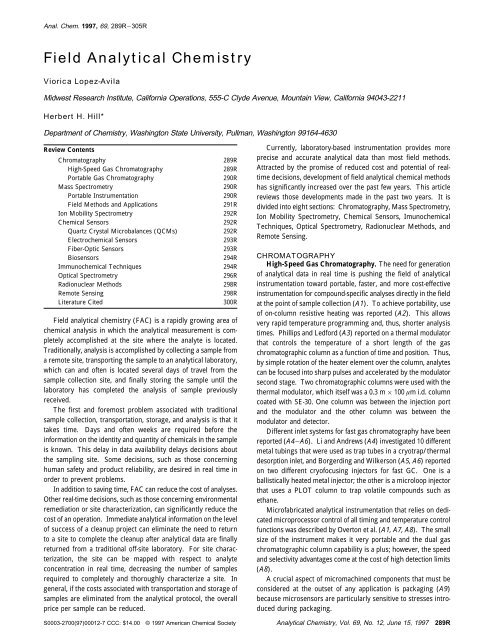
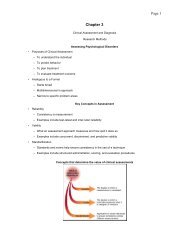
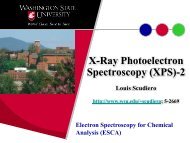
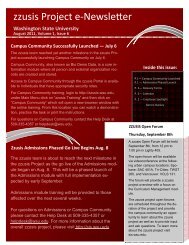
![Graduate School Policies & Procedures Manual 2011 - 2012 [PDF]](https://img.yumpu.com/50747405/1/190x245/graduate-school-policies-procedures-manual-2011-2012-pdf.jpg?quality=85)
